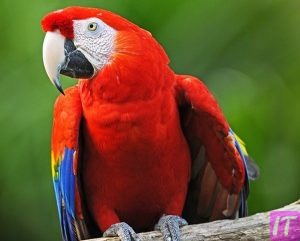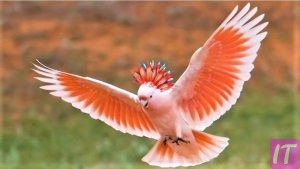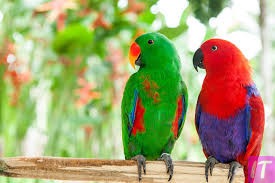Few creatures captivate the human eye quite like the vibrantly colored parrots. These avian marvels are not only celebrated for their striking plumage but also for their remarkable intelligence. With over 393 species of parrots inhabiting diverse ecosystems, one might wonder which regions boast the most dazzling specimens.
The spectacular Hyacinth Macaw, the world’s largest parrot, calls the lush rainforests of South America home. Australia’s northeastern rainforests and the remote islands of the South Pacific house the vividly hued Rainbow Lorikeets. Parrots of unparalleled beauty often flourish in tropical regions teeming with biodiversity, underscoring the crucial need for conservation efforts.
Where do the most beautiful parrots in the world live?
The vibrant and diverse landscapes of tropical rainforests are home to many of the world’s most beautiful parrots. These rainforests, rich in biodiversity, provide an ideal environment for parrots to thrive. High tree canopies and abundant food sources contribute to their vibrant colors and unique patterns. Parrots like the Scarlet Macaw flourish in these lush surroundings. The dazzling colors of these birds reflect the rich and varied ecosystem.
Australia is another hotspot for stunning parrot species. The country boasts over 55 parrot species that are found in diverse habitats, from rainforests to woodlands. Notably, the Rainbow Lorikeet, with its vivid blue, green, and red feathers, is a sight to behold. These parrots are often seen in urban areas, adding color to city parks and gardens. Their adaptability makes them popular and cherished.
In South America, the Amazon rainforest is a prime habitat for many extraordinary parrots. The majestic Hyacinth Macaw, the largest parrot species, showcases brilliant blue feathers. These parrots favor the open woodlands of Brazil, Bolivia, and Paraguay. Their strong beaks are well-adapted to crack hard nuts and seeds found in their environment. Conservation efforts are crucial to protect these magnificent birds.
Unique parrot species can also be found on the islands of the South Pacific. For example, the critically endangered Kakapo of New Zealand is famous for its nocturnal habits and inability to fly. The Philippines is home to the grand Philippine Cockatoo, known for its white plumage with red and yellow highlights. These islands provide sanctuary to species that cannot be found elsewhere. The continued survival of these birds relies heavily on local preservation initiatives.

The Trove of Tropical Rainforests
Tropical rainforests are magical realms brimming with life, and they are home to some of the most stunning parrots on earth. These forests, with their dense foliage and high humidity, provide an ideal environment for parrots. Their rich biodiversity supports a variety of parrot species, each adorned with vibrant colors. Parrots such as the Eclectus Parrot thrive in rainforests from the Solomon Islands to Papua New Guinea. Their bright plumage helps them blend into the colorful tapestry of the canopy.
The Amazon rainforest, often called the ‘lungs of the Earth,’ is a crucial habitat for exotic parrots. This vast jungle shelters the eye-catching Blue and Yellow Macaw. These birds are often seen flying in pairs, showcasing their striking colors against the lush green backdrop. The forest’s abundance of fruit and nuts provides ample food sources. However, deforestation threatens these natural havens, making conservation efforts vital.
Africa’s rainforests, though less discussed, are equally important for bird diversity. Species like the African Grey Parrot, known for its remarkable intelligence, inhabit these regions. These parrots are often found in the Congo Basin. Their ability to mimic human speech makes them popular pets, but this also endangers their wild populations. Protecting their habitats is necessary to prevent their decline in the wild.
Rainforest regions such as Southeast Asia host unique parrot species like the Green Parakeet. These rainforests offer not just a home but a sanctuary for these birds. The towering trees and thick underbrush provide shelter from predators. A diverse array of flora ensures a steady supply of food year-round. It’s a delicate balance, and preserving these ecosystems is crucial for the survival of many parrot species.
Exploring the diverse Parrot Species in Australia
Australia is famous for its diverse and colorful parrot species. With over 55 species inhabiting the continent, it’s a haven for parrot lovers. The country’s varied landscapes, from deserts to rainforests, provide unique habitats for these birds. Cockatoos, for instance, are a group of parrots that are iconic to Australia. Known for their striking crests and loud calls, they can be found in many regions across the continent.
One of the most famous Australian parrots is the Rainbow Lorikeet. These birds are known for their bright, multi-colored feathers and playful nature. They are often seen in urban and suburban areas, feeding on nectar from flowering trees. Their cheerful presence makes them a favorite among bird watchers. Urbanization poses threats, but they show amazing adaptability.
The Budgerigar, or Budgie, is another well-loved bird that hails from the Australian outback. These small parrots have a vibrant green and yellow plumage with black markings. In the wild, they travel in large flocks and can cover great distances in search of food and water. Budgies are popularly kept as pets worldwide. Their natural habitat is in the dry regions of central Australia.
Australia’s rainforests are home to the endangered Swift Parrot. These small, green parrots migrate from Tasmania to mainland Australia during the winter. They rely heavily on eucalyptus trees for food and nesting. Habitat loss is a significant threat to their survival. Conservation efforts are ongoing to protect their remaining habitats and ensure their long-term survival.
The Lush Habitats of South American Parrots
South America is a vibrant home to some of the world’s most beautiful parrots. The Amazon rainforest, spanning several countries, is a key habitat for these birds. Here, the Scarlet Macaw, with its striking red, blue, and yellow feathers, rallies the canopy with its calls. These parrots inhabit the treetops, navigating the dense forest with ease. The abundance of fruits and nuts in the Amazon sustains a rich parrot population.
Another notable species is the Blue-and-Yellow Macaw. These parrots prefer open forests and woodlands, and are often found near rivers. Their vivid blue and yellow plumage makes them a standout in the forest. The Pantanal region in Brazil is a favored habitat for these macaws. Conservation efforts focus on preserving these areas to ensure their survival.
The Andes Mountains also provide a unique environment for South American parrots. Species like the Mountain Parakeet thrive at high altitudes. These birds are adapted to cooler temperatures and are often seen in large flocks. They feed on seeds and fruits found in the mountainous regions. The varied terrain offers both challenges and opportunities for these resilient birds.
In the tropical regions of Southern Brazil, the Green-winged Macaw is a frequent sight. These parrots are known for their strong beaks, which they use to crack open hard-shelled nuts. The forests and swamps in this region offer an ideal refuge. Despite threats from habitat loss, conservation projects are making strides in protecting these magnificent birds. Local communities play a significant role in these efforts.
Paraguay’s Chaco region, with its dry forests, is another key habitat for parrots like the Yellow-faced Parrotlet. These small, green parrots are known for their distinct yellow markings on their faces. They are adept at surviving in harsh conditions, with their diet comprising seeds and insects. Efforts to monitor and protect their habitats are ongoing. Maintaining biodiversity in these regions is crucial for their continued existence.
Island Paradises: Home to Unique Parrot Species
Islands around the world are sanctuaries for unique and rare parrot species. New Zealand, for example, is home to the Kakapo, one of the rarest parrots globally. Known for its nocturnal and flightless nature, the Kakapo is a marvel of evolution. These parrots are critically endangered, with ongoing conservation programs in place. They inhabit forested areas where they can blend seamlessly into their environment.
In the Philippines, the colorful Philippine Cockatoo, also known as the Red-vented Cockatoo, is found. These parrots have striking white feathers with red and yellow highlights. They prefer coastal forests and mangroves, where they find food such as fruits, seeds, and nuts. Habitat loss due to deforestation poses a significant threat to their population. Efforts to protect and replenish their habitats are crucial for their survival.
The Lesser Antilles in the Caribbean are home to the endangered Saint Lucia Parrot. This parrot is known for its vibrant green body and blue-tipped wings. These birds favor the island’s rainforests, which provide abundant food and nesting sites. Conservation initiatives are in place to safeguard their remaining habitats. Community awareness and involvement play vital roles in these efforts.
Australia’s island state of Tasmania hosts the Swift Parrot during its breeding season. These small parrots are bright green with patches of red and blue on their wings. They migrate from mainland Australia to Tasmania during the spring. Eucalyptus trees in the region provide both food and nesting sites. Habitat preservation in Tasmania is essential to support their breeding success.
The Galápagos Islands, renowned for their unique biodiversity, are home to the Red-footed Booby Parrot. These parrots are characterized by their colorful plumage and distinctive red feet. They thrive in the island’s dry coastal areas. Conservation programs aim to maintain the delicate ecological balance of the Galápagos. Protecting these ecosystems ensures the survival of the Red-footed Booby Parrot and other unique species.

Parrot Conservation: Preserving their Beautiful Habitats
Parrot conservation is vital for maintaining the diversity and beauty of these remarkable birds. Many species face threats from habitat loss and climate change. Conservation programs focus on protecting the natural ecosystems where these parrots thrive. Initiatives such as reforestation and habitat restoration are crucial. These efforts help ensure that parrots have safe places to live and breed.
Education and community involvement play significant roles in parrot conservation. Local communities are encouraged to participate in preserving natural habitats. Schools and organizations often conduct awareness campaigns. These educational programs highlight the importance of protecting parrot species. They also teach sustainable practices that benefit both humans and wildlife.
Breeding programs in captivity are another strategy to protect endangered parrot species. Zoos and conservation centers work to increase parrot populations. They provide safe environments for breeding and nurturing young parrots. These programs are essential for species that face high risks in the wild. Successful breeding can lead to reintroduction into natural habitats.
International cooperation is critical for effective parrot conservation. Many parrot species migrate across different regions and countries. Collaborative efforts between nations help in creating comprehensive conservation plans. Agreements and policies are made to protect migrating parrots’ routes. Such partnerships enhance the overall impact of conservation measures.
Technological advancements also aid in parrot conservation. Drones and satellite tracking are used to monitor parrot populations. These tools provide valuable data on parrot behavior and habitat usage. Scientists can use this information to develop effective conservation strategies. Modern technology makes it easier to track and protect these vibrant birds.
Frequently Asked Questions
Parrots are not just strikingly beautiful but also incredibly diverse. Below are some common questions and answers related to the habitats and conservation of these fascinating birds.
1. What are the threats facing parrot populations?
Parrot populations face numerous threats, including habitat destruction due to deforestation and urbanization. Illegal trapping and trading of parrots for the pet industry also pose significant risks. These activities disrupt their natural habitats, reducing their numbers in the wild.
Climate change is another threat impacting food availability and nesting sites for many parrot species. Conservation initiatives aim to address these challenges by protecting natural habitats, enforcing anti-poaching laws, and supporting breeding programs.
2. How do rainforests support parrot biodiversity?
Rainforests offer an ideal environment rich in resources that support parrot biodiversity. The dense canopy provides abundant food sources like fruits, nuts, and seeds, keeping parrots well-nourished year-round. Additionally, the tall trees offer safe nesting sites away from ground predators.
The complex layers of rainforest vegetation create microhabitats catering to different species’ needs. This layered structure allows multiple parrot species to coexist by occupying various niches within the same area.
3. Why are parrots good indicators of environmental health?
Parrots serve as excellent indicators of environmental health due to their sensitivity to ecosystem changes. A decline in parrot populations often signals issues such as habitat loss or ecosystem imbalance.
Monitoring parrot populations can help scientists identify environmental problems early on. Conservation efforts targeting parrots can lead to broader ecosystem protection benefiting multiple species.
4. Which island is home to the critically endangered Kakapo?
The Kakapo is a critically endangered flightless parrot native to New Zealand’s islands. This bird primarily resides on predator-free sanctuaries such as Codfish Island (Whenua Hou) and Anchor Island.
Conservation efforts have been intensified with strict measures like controlling introduced predators and using technology for monitoring chicks’ growth rates. The survival of this unique nocturnal bird relies heavily on sustained human intervention.
5. What makes the Hyacinth Macaw unique among parrots?
The Hyacinth Macaw stands out as one of the largest and most strikingly colored parrots globally, dazzling with its vibrant blue feathers.
Native to parts of Brazil, Bolivia, and Paraguay’s open woodlands areas rich in palms; they are known for their powerful beaks capable of cracking hard nuts like coconuts indicating specialized dietary needs hence making them susceptible if favored trees disappear over time through logging activities rendering conservation critical towards their continued existence highlighting interdependence between species & habitats strength relationships throughout ecosystems showcasing delicate balance & importance proactive actions now future generations could enjoy marveling beauty firsthand alongside ensuring healthy functioning planet overall delicate balance & importance proactive actions now future generations could enjoy marveling beauty firsthand alongside ensuring healthy functioning planet overallaujhj upgrading ydytyyyg.
Conclusion
Preserving parrot habitats is not just about saving beautiful birds; it’s about protecting entire ecosystems. The rich biodiversity these habitats support is crucial for maintaining environmental balance. Efforts in conservation, education, and international collaboration are vital to ensure these vibrant species continue to thrive.
By safeguarding these environments, we contribute to a future where diverse parrot species coexist harmoniously with humans. Continued commitment to conservation initiatives will help protect these stunning birds for generations to come. Every small action counts in making a significant impact on their survival.







